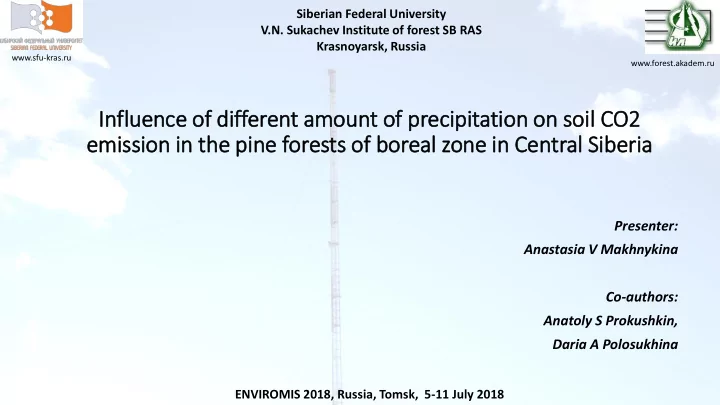

Siberian Federal University V.N. Sukachev Institute of forest SB RAS Krasnoyarsk, Russia www.sfu-kras.ru www.forest.akadem.ru Influence of different amount of precipitation on soil СО2 emis ission in in the pin ine forests of boreal l zone in in Central Sib iberia Presenter: Anastasia V Makhnykina Co-authors: Anatoly S Prokushkin, Daria A Polosukhina ENVIROMIS 2018, Russia, Tomsk, 5-11 July 2018
Soil CO 2 sequestration in Russia: a significant role of boreal forests (lack of data for vegetation models) • The forests of Russia make up about 23% of the entire forest area of the whole world. They contain about 43 Pg C in terrestrial vegetation, including 35 Pg C in living biomass (Shvidenko et al., 2009). • International Institute for Applied Systems Analysis Russian territory acted as a source of CO 2 at a rate of 0.53 Gt C g -1 (Nilsson et al., 2000). Institute of Physico-Chemical and Biological Problems of Soil Science, Russian Federation – the Russian territory is completely carbon sink in the amount of 0.81-1.10 Gt C g -1 (Kurganova et al., 2008) + Dolman et al. (2012) obtained by the upscaling eddy covariance data that carbon sink is 0.63 PgC yr - 1. Net ecosystem carbon budget (gC m2); negative values indicate a carbon source, positive values a carbon sink (Shvidenko and Schepaschenko, 2014) 2 http://tsmithrussia.weebly.com/population-and-settlement.html
Soil Respiration • As an important component of the carbon cycle, soil respiration includes the total CO 2 released by the respiration of plant roots, soil microorganisms and mycorrhizae Anthropogenic impact: Natural external factors: • clear cutting and logging, • temperature, • pollution, • precipitation, • fossil fuel burning • nutrient supply
Main goal • to consider the reaction of soil СО 2 emission to the different amounts of precipitation in pine forests of Central Siberia. Study objectives: (1)to characterize temporary changes in soil СО 2 emissions in pine forests of Central Siberia in areas with a differentiated amount of precipitation; (2)to study the influence of the hydrothermal conditions of a particular season on the formation of a flow of CO 2 ; (3)determine optimal moisture conditions for maximum soil CO 2 emissions in a particular region.
Research Region http://rareearth.ru/ru/pub/20151125/01827.html
Research Station « Zotino Tall Tower Observation Facility ZOTTO» 6
Meteorological Conditions Climate of our region is a very continental: • Absolute minimum temperature is -54 ° C , the absolute maximum temperature is 36 ° C . • The amplitude of the oscillations of the average monthly temperature is 42 ° C . • The average annual relative humidity is 76%. • The amount of precipitation is 590 mm per year. 7
Study Site Lichen pine forest (10P) Forest age: 75 years N 60 ° 47 ’ 57 ’’, E 089 ° 21 ’ 23 ’’ 8
Experimental design Water treatments: 0%, 25%, 50% and 100% from the precipitation events (rain)
Experimental design CO 2 25% 8 hours soil 50% • After each rain during the observation period (June-September) • Duration: 2 years 10
Research Methods • Soil efflux - CO 2 flux system based on the infrared gas analyzer – LI- 8100 (Li-Cor Biogeosciences Inc., USA). • Soil temperature - Soil Temperature Probe Type E (Omega, USA) in three depths – 5, 10, 15 cm. • Volumetric soil moisture - Theta Probe Model ML2 (Delta T Devices Ltd., UK). 11 11 11
Meteorological characteristics of the observation period • Air temperature: mean seasonal temperature of 2016 was in 30 % higher comparing to the mean value; 2015 – was quite close to the mean but in June was warmer in 35 %. • Precipitation: amount of precipitation in 2016 in the mid of season was in 25 %, at the start and end of it – in 60 % smaller than mean values; 2015 – in the mid of season in 75%, at the start and end of it – in 15 and 45 % respectively higher than mean values. Main differences in 2015 – in the mid of season, 2016 – at the start and end of season.
Soil CO 2 dynamics for two seasons of experiment 2015: • max flux occurred at the middle of growing season; • max flux – site with 0% precipitation; • factor of flux inhibition – overmoistened. 2016: • max flux presented in the second half of June-start of July, • max flux – site with 100% precipitation; • factor of flux inhibition – lack of moisture/drought.
Dependence CO 2 emission from the soil temperature • 2015
Dependence CO 2 emission from the soil temperature • 2016
Q 10 Coefficient • Natural conditions (100%): the same response • 50%: the increase in 20 % in more precipitated year • 0 and 25%: the increase in 40 and 50 % respectively in more precipitated year
Distribution of all measurements of soil СО 2 emission by the soil moisture 2015 2016
SUMMARY 1. Changes in the amount of precipitation can inhibit (drought and overmoistened conditions) or intensify (optimal moistening conditions) the soil CO 2 emission. 2. The optimum moisture content of the soil is 20-30%: there is no restriction on the moisture factor. 3. The temperature exponential dependence is maximal at optimum soil moisture.
THANK YOU FOR YOUR ATTENTION! The reported study was funded by Russian Foundation of Basic Research № 18-34-00736 « The effect of the main limiting factors (precipitation and soil nitrogen content) to the soil CO 2 emission in the boreal forests of Central Siberia » and Krasnoyarsk Regional Fund of Science.
Recommend
More recommend